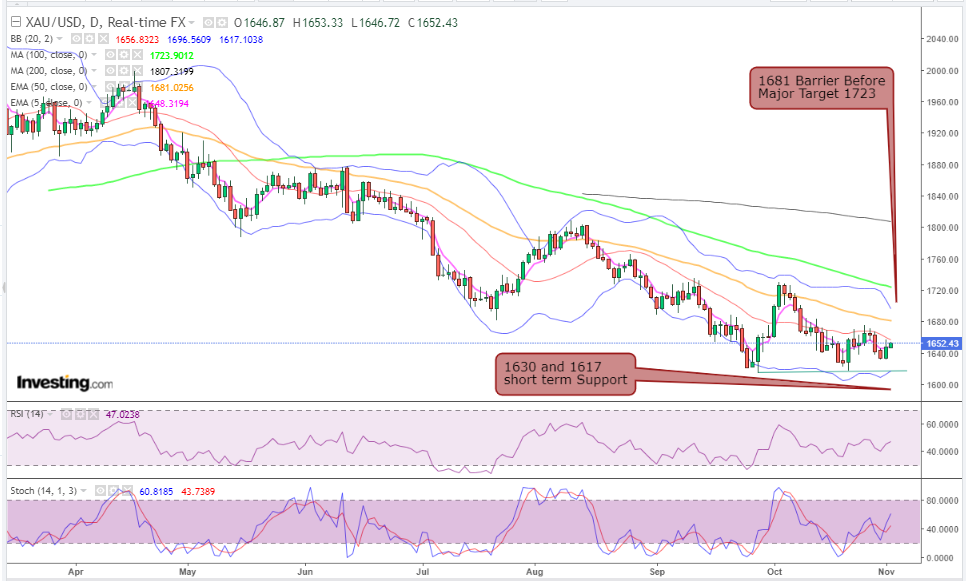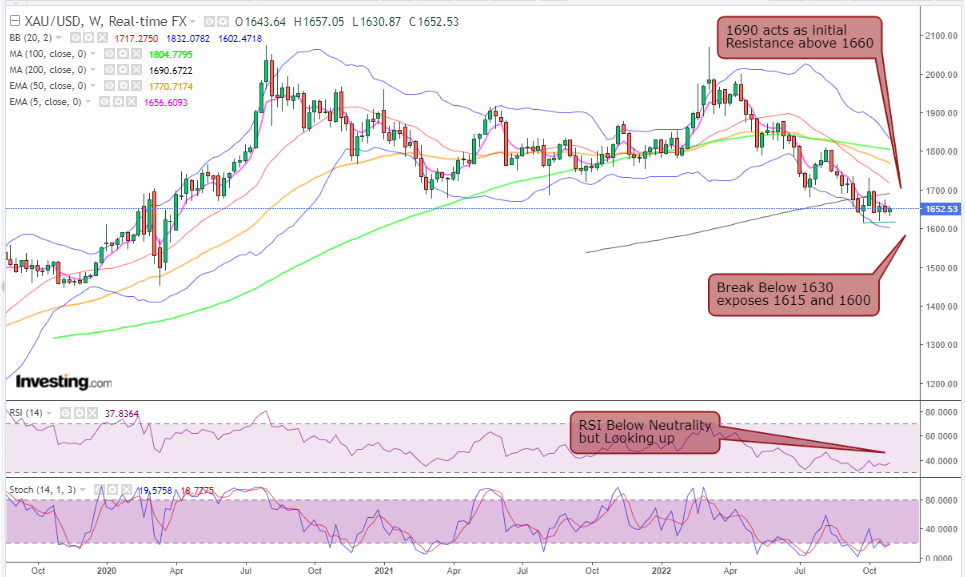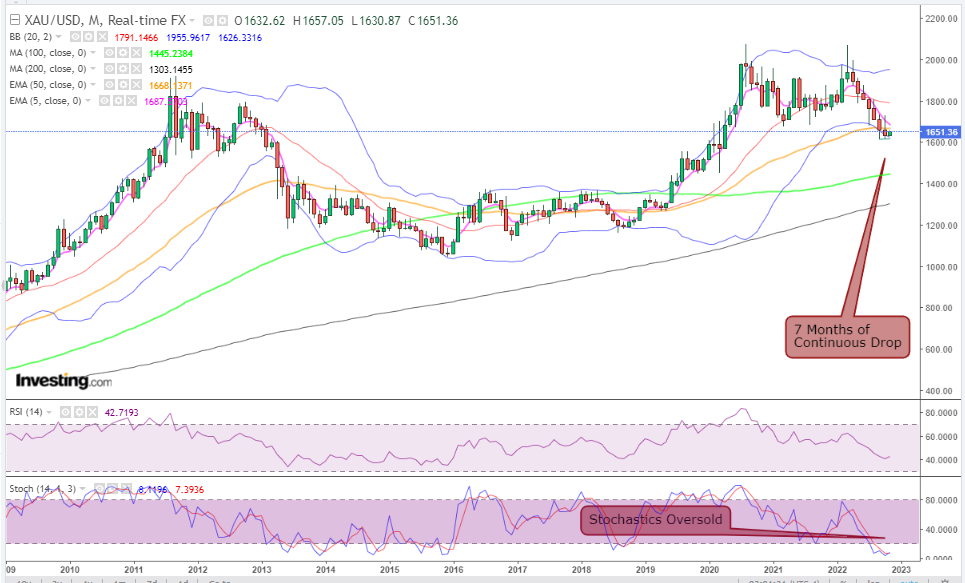- Aside from today's rate hike, attention on October jobs report
- If below estimated 191,000, it will build hopes for a Fed pivot on rates
- If close to or above September’s 263,000, Fed will stay aggressive on rates
- Gold could test $1,735 higher by Friday or lower $1,600, depending on outcome
Where could gold go in the next 72 hours?
With the sixth US rate hike due to arrive later on Wednesday, the yellow metal has another epic hurdle to cross by Friday in the form of the October US jobs report.
Beyond what the Fed does or says Wednesday, the so-called nonfarm payrolls report for October will determine not just near-term direction for gold and its nemesis, the dollar, but also set the tone for Fed action and speak—until the release of the November jobs report, which will arrive in time for the central bank’s next rate decision on Dec. 15.
Thus, the October jobs report will provide the earliest signs of whether the Fed is ready to start easing on rates by the end of the year. In order for the central bank to do that, actual jobs growth for last month must be well below the 191,000 positions that economists think were created.

Charts courtesy of SKCharting, with data powered by Investing.com
The Fed is all but certain to deliver a 75 basis point (bp) rate hike on Wednesday, the fourth of its kind, as it keeps to a series of jumbo-sized rate increases to get inflation back to its target.
Yet, continued hopes for a Fed pivot—a buzzword that simply means the central bank might opt for a lower rate hike than 75 bp—in December added to risk appetite across markets on Tuesday, despite the latest US labor data being unsupportive to that notion.
So, where could gold go between now and Friday?
According to the temperaments of technical charts at least, a test of $1,735 could happen on the high end if the September jobs data comes in weaker than expected, stirring speculation once again of a Fed pivot, said Sunil Kumar Dixit, chief technical strategist at SKCharting.com.
But if the jobs growth is bigger than expected—coming close to or beyond September’s 263,000—then the Fed will almost likely stay the course with another 75 bp hike in December. That’s an outcome that could severely cost gold longs, sending them back to the periphery of low $1,600 pricing, said Dixit.
He adds:
“After a continuous drop from its unsuccessful breach of its all-time high of $2,073, gold has been falling continuously for seven months in a row. Now, the current rebound from the $1,615 base demand zone has enough room for an up move to test $1,690 and $1,723. But this requires clearing the immediate resistance of $1,660 first”.

Dixit said any profit booking from such mid-level resistance areas could trigger bearish momentum, pushing gold back toward the $1,630 and $1,615 support areas.
“Breaking below 1615 will expose the metal to $1,598 rather quickly,” he said.
On longer time frame monthly charts, a potentially bearish crossover of the 5-week Exponential Moving Average (EMA) of $1,687 with the 50-week EMA of $1,668 may keep any initial rebound limited.
“Provided gold bulls manage to break above the $1,725-$1,735 horizontal resistance zone, the rally towards $1791 should be the next area of interest,” Dixit said.
“On the contrary, consolidation below $1,630-$1,615 adds to bearish continuation aiming for $1,560 in the mid term.”
"From a short term perspective, we see gold straddling $1,660-$1,690 on the higher side and $1,630-$1,600 on the lower side.”

Investors have been on the edge since summer over the Fed’s aggressive rate hike regime that went from March’s 25 bp hike to 75 bp in June, which the central bank has maintained.
The Fed’s target for inflation is a mere 2% a year and it has said it will not back off on interest rate hikes until it achieves its aim.
Inflation, as measured by the Consumer Price Index, stood at 8.2% during the year to September, not too far from the 40-year peak of 9.1% noted in the 12 months to June.
Since March, the central bank has raised rates by 300 bp from an original base of just 25. The Fed intends to add another 125 bp to rates before the year-end.
In Tuesday’s trading, the dollar initially tumbled against a basket of six currencies led by the euro on speculation over the Fed pivot, then volleyed between positive and negative territory through the day as markets kept wavering on whether such a was indeed possible at this point.
Ed Moya, analyst at online trading platform OANDA, doesn’t think the central bank is ready to relax anything, for now, adding:
“Momentum was building on expectations for the Fed to downshift their tightening pace in December, but now that call seems like it may have been premature. Rates might need to stay higher for longer if the labor market is still healthy and inflation ends up being stickier than markets are initially thinking.”
The number of available jobs for Americans came in well above expectations in September, with nearly two positions for every job-seeker, the Labor Department said Tuesday in its Job Openings and Labor Turnover Survey (JOLTS) report for September that appeared to complicate the Fed’s inflation fight.
A sterling labor market has been one of the greatest redeeming qualities of the US economy over the past two years. But it is also an anathema of sorts for the Fed as robust wage growth has added to the worst inflation in four decades. The JOLTS report showed there were 10.72 million available positions in September, above the estimated 9.85 million.
The JOLTS report “reverses a recent decline and raises the risk of a tight jobs market for longer and the Fed needing to hike more,” economist Adam Button said in a post on the ForexLive forum, noting that there were 1.9 positions available for every job seeker.
The JOLTS data came ahead of Friday’s more important nonfarm payrolls report for October, which the Fed uses as a key benchmark for rate decisions. Economists expect the Labor Department to report that the United States added 191,000 nonfarm jobs last month, versus September’s growth of 263,000.
Fighting inflation isn’t the Fed’s only agenda. It is also mandated to ensure “maximum employment” for Americans, further adding to the central bank’s headache in ensuring a balance between the two priorities even as it tries to cool employment in order to get price pressures down. Under the Fed’s definition, maximum employment is achieved when the monthly jobless rate is at 4% or below. The central bank has scored full points on this task since the start of this year, as unemployment hit 4% in January and has stayed below that level.
Disclaimer: Barani Krishnan uses a range of views outside his own to bring diversity to his analysis of any market. For neutrality, he sometimes presents contrarian views and market variables. He does not hold positions in the commodities and securities he writes about.
